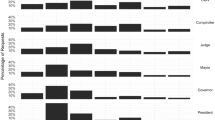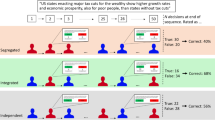Abstract
Americans are turning to the Internet to learn about politics in greater and greater numbers. Under the current “Web 2.0” paradigm in which users are encouraged to interact with online content, voters encountering political information on the Internet are typically exposed to more than just the news; online information is often colored by the reactions of previous readers, whether in the form of displayed comments or in readily apparent tallies of the number of “likes” or “shares” a particular item has received. In this paper we consider the effect these social cues have on online political information search and evaluation. Using processing-tracing software to monitor the patterns of information search and evaluation among our subjects, we find that social cues can function as a heuristic, allowing voters to reach judgments similar to those of their more informed counterparts. However, we also find that negative cues can adversely influence candidate evaluation, making subjects less disposed to a candidate than they would be in the absence of such signals.



Similar content being viewed by others
Notes
Report available at http://www.pewinternet.org/2009/04/15/the-internets-role-in-campaign-2008/.
Indeed, the social cues common to online media have begun to appear in more traditional outlets, as some news programs now incorporate viewer comments and reactions into their stories.
All figures were based on website visits on April 19th, 2015.
In a largely positive information environment, another mechanism that may decrease overall information search is suggested by Marcus and colleague’s “Affective Intelligence Theory” (Marcus et al. 2000). Affective Intelligence Theory proposes that a positive political context activates the brain’s “disposition” system, resulting in a decreased motivation to expand cognitive effort. In effect, positive signals tell the voter that the status quo is fine and there is no need to be on alert or vigilant. Thus, positive signals surrounding political information should decrease a person’s need to acquire information.
We use a primary campaign to eliminate reliance on party identification when making a voting decision. In a primary, our subjects will presumably need more information to make their choices, giving us more leverage on our research question.
The DPTE software is free to use and available to any researcher at www.processtracing.org.
When we added a measure of political expertise to our models, subjects’ level of political sophistication had no substantive effects on the results reported here. Complete results are available from the authors.
These and subsequent estimates from our statistical models are generated using the “sim” function for the Zelig statistical package in R (Imai et al. 2012).
Recall that 22 of the 33 items pertaining to our manipulated candidate were marked with social cues. Of these, 11 items were initially presented with 20–30 likes or dislikes. The other 11 items contained 10–19 likes or dislikes and the final 11 items had no cues attached at all. The effects we report hold for both high and low–cued items, so we combine them here.
While all subjects in our treatment groups were alerted to the presence of comments on a news item, in order to actually view the comments subjects had to choose to open a separate panel within the information box, much like visitors to Internet news sites must choose to read user comments.
In the “negative + comments” treatment, the p value for the dummy variable is .051.
A likely explanation for the increase in processing time is a “cognitive response” mechanism (Mutz 1998). Our subjects are probably taking the time to stop and think about the cues and what they imply. This interpretation is bolstered by the fact that subjects in the negative cues only group (i.e., no comments, only “dislikes”), also saw their processing time increase significantly.
Although there were three candidates in the primary, our design focused the bulk of the cues on one politician. Our goal was to make one candidate appear to be either exceedingly popular or unpopular. The other two “non-manipulated” candidates received a smattering of cues simply to make the environment more realistic.
To further investigate whether the distribution of cues mattered, we re-ran our analysis with dummy variables indicating whether the subject took the experiment early in the process (among the first third of subjects) or late (the last third). Since the later groups saw a different array of cues—because of the cues left by previous participants—we might see differences in information acquisition among these groups. However, the likelihood of opening an item declined for all subjects, regardless of when they took the study.
References
Banerjee, A. V. (1992). A simple model of herd behavior. The Quarterly Journal of Economics, 107, 797–817.
Bartels, L. M. (1996). Uninformed votes: Information effects in presidential elections. American Journal of Political Science, 40(1), 194–230.
Bartels, L. M. (2002). Beyond the running tally: Partisan bias in political perceptions. Political Behavior, 24(2), 117–150.
Berger, J., & Milkman, K. L. (2012). What makes online content viral? Journal of Marketing Research, 49(2), 192–205.
Berinsky, A. J., Huber, G. A., & Lenz, G. S. (2012). Evaluating online labor markets for experimental research: Amazon. com’s mechanical turk. Political Analysis, 20(3), 351–368.
Buhrmester, M., Kwang, T., & Gosling, S. D. (2011). Amazon’s mechanical turk a new source of inexpensive, yet high-quality, data? Perspectives on Psychological Science, 6(1), 3–5.
Carpini, M. X. D., & Keeter, S. (1993). Measuring political knowledge: Putting first things first. American Journal of Political Science, 37, 1179–1206.
Cohen, G. L. (2003). Party over policy: The dominating impact of group influence on political beliefs. Journal of personality and social psychology, 85(5), 808–822.
Dancey, L., & Sheagley, G. (2013). Heuristics behaving badly: Party cues and voter knowledge. American Journal of Political Science, 57(2), 312–325.
Delli Carpini, M. X., & Keeter, S. (1996). What Americans know about politics and why it matters. New Haven: Yale University Press.
Downs, A. (1957). An economic theory of democracy. New York: Harper and Row.
Gaines, B. J., Kuklinski, J. H., Quirk, P. J., Peyton, B., & Verkuilen, J. (2007). Same facts, different interpretations: Partisan motivation and opinion on iraq. Journal of Politics, 69(4), 957–974.
Imai, K., King, G., and Lau, O. (2012). Zelig: Everyone’s statistical software, R Package Version 3.5.5. http://CRAN.R-project.org/package=Zelig
Kuklinski, J. H., & Quirk, P. J. (2000). Reconsidering the rational public: Cognition, heuristics, and mass opinion. In A. Lupia, M. D. McCubbins, & S. L. Popkin (Eds.), Elements of reason: Cognition, choice, and the bounds of rationality (pp. 153–182). Cambridge: Cambridge University Press.
Kuklinski, J. H., Quirk, P. J., Jerit, J., Schwieder, D., & Rich, R. F. (2000). Misinformation and the currency of democratic citizenship. Journal of Politics, 62(3), 790–816.
Lau, R. R., Andersen, D. J., & Redlawsk, D. P. (2008). An exploration of correct voting in recent us presidential elections. American Journal of Political Science, 52(2), 395–411.
Lau, R. R., & Redlawsk, D. P. (1997). Voting correctly. American Political Science Review, 91, 585–598.
Lau, R. R. and Redlawsk, D. P. (2001). Advantages and disadvantages of cognitive heuristics in political decision making. American Journal of Political Science, pages 951–971.
Lau, R. R., & Redlawsk, D. P. (2006). How voters decide: Information processing during election campaigns. Cambridge: Cambridge University Press.
Lavine, H. G., Johnston, C. D., & Steenbergen, M. R. (2012). The ambivalent partisan: How critical loyalty promotes democracy. Oxford: Oxford University Press.
Lodge, M., & Taber, C. S. (2000). Three steps toward a theory of motivated political reasoning. In A. Lupia, M. D. McCubbins, & S. L. Popkin (Eds.), Elements of Reason: Cognition, choice, and the bounds of rationality. Cambridge: Cambridge University Press.
Lodge, M., & Taber, C. S. (2013). The rationalizing voter. Cambridge: Cambridge University Press.
Lupia, A. (1998). The democratic dilemma: Can citizens learn what they need to know?. Cambridge: Cambridge University Press.
Marcus, G. E., Neuman, W. R., & MacKuen, M. (2000). Affective intelligence and political judgment. Chicago: University of Chicago Press.
McDermott, M. L. (2005). Candidate occupations and voter information shortcuts. Journal of Politics, 67(1), 201–219.
Muchnik, L., Aral, S., & Taylor, S. J. (2013). Social influence bias: A randomized experiment. Science, 341, 647–651.
Mutz, D. C. (1998). Impersonal influence: How perceptions of mass collectives affect political attitudes. Cambridge: Cambridge University Press.
Nickerson, R. S. (1998). Confirmation bias: A ubiquitous phenomenon in many guises. Review of General Psychology. Review of General Psychology, 2(2), 175.
Nyhan, B., & Reifler, J. (2010). When corrections fail: The persistence of political misperceptions. Political Behavior, 32(2), 303–330.
Popkin, S. L. (1991). The reasoning voter: Communication and persuasion in presidential campaigns. Chicago: University of Chicago Press.
Redlawsk, D. P. (2002). Hot cognition or cool consideration? Testing the effects of motivated reasoning on political decision making. The Journal of Politics, 64(04), 1021–1044.
Redlawsk, D. P., Civettini, A. J. W., & Emmerson, K. M. (2010). The affective tipping point: Do motivated reasoners ever âĂIJget itâĂİ? Political Psychology, 31(4), 563–593.
Sniderman, P. M., Brody, R. A., & Tetlock, P. E. (1991). Reasoning and choice. Cambridge: Cambridge University Press.
Taber, C. S., & Lodge, M. (2006). Motivated skepticism in the evaluation of political beliefs. American Journal of Political Science, 50(3), 755–769.
Zaller, J., & Feldman, S. (1992). A simple theory of the survey response: Answering questions versus revealing preferences. American Journal of Political Science, 36, 579–616.
Zaller, J. R. (1992). The nature and origins of mass opinion. Cambridge: Cambridge University Press.
Author information
Authors and Affiliations
Corresponding author
Additional information
Financial support for this project comes from NSF Grant SoCS-IIS-096841 awarded to the second and third author. The development of the DPTE software system (www.processtracing.org) was supported in part by National Science Foundation grant SES-0647738 to the second author. Earlier versions of this paper were presented at a number of conferences, including the 2015 WPSA meeting and the 2015 MPSA conference. We thank participants at those seminars and a number of anonymous reviewers for helpful suggestions and improvements. Replication data for this study is available at https://dataverse.harvard.edu/dataverse/polbehavior.
Rights and permissions
About this article
Cite this article
Pierce, D.R., Redlawsk, D.P. & Cohen, W.W. Social Influences on Online Political Information Search and Evaluation. Polit Behav 39, 651–673 (2017). https://doi.org/10.1007/s11109-016-9374-4
Published:
Issue Date:
DOI: https://doi.org/10.1007/s11109-016-9374-4




